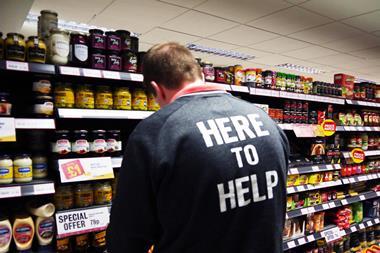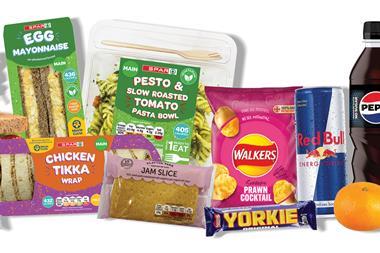The whirlwind of events at the tail end of 2017 mean the c-store sector could look very different in 2018 to how it does now. The latest supply deals and mergers signal a future of consolidation for the sector, while legislation, technology and consumer demand for food solutions are reshaping the c-store mix. Some commentators are predicting a bright future; others forecasting clouds on the horizon. Here industry experts and retailers look ahead and highlight the areas store owners will need to concentrate on to weather any coming storm
Get ready to play to your strengths
James Lowman, chief executive, Association of Convenience Stores

“Consumer habits are changing, and the rate of change is accelerating. Many of these changes play to the convenience sector’s strengths: little and often shopping, convenience, smaller households and smaller homes all meaning less space and less planned weekly shopping.
However, there are threats, too. People may be less likely to cook from scratch a meal with ingredients bought from a large out-of-town store, but they’re more likely to eat out, so stores not offering food to go will miss out on this opportunity.
Some of the reasons for these changes are down to rapid technological advances. Online grocery shopping has helped some convenience stores, because that mode of shopping is complementary to top-up shopping from local stores. But short lead times and small minimum orders from operators such as Amazon pose a new threat.
There are some great opportunities that technology brings our sector, though, in terms of better targeted and more impactful marketing, or more efficient store operations, or just communications with suppliers and other retailers.
There’s no doubt that Brexit continues to dominate the news agenda. However, the research that we’ve carried out with retailers suggests that, for the most part, the sector is still undecided about the impact that leaving the EU will have on their prospects. Convenience stores tend to be robust in the face of national and indeed international uncertainty, so we aren’t expecting a significant impact while the negotiations continue through 2018.
One area that will continue to be a challenge is the impact of rising wage costs. The Autumn Budget included a new National Living Wage rate of £7.83, which will put further pressure on working hours and staff numbers in the sector. With technology advancing rapidly, it is likely that stores will look toward automation, such as self-service tills, to future proof their businesses against the impact of wage increases.
We can’t ignore the massive changes taking place in our market. Three multiple retailing groups – Tesco, Co-op and Morrisons – have entered the wholesaling sector in different ways, while P&H has recently entered administration. When the dust settles, will the changes in the sector in 2017 lead to more and better choice for retailers, or will it lead to the market becoming dominated by a few huge companies? Only time will tell.”
Legislation will have an impact
Pete Cheema, chief executive, Scottish Grocers Federation

“The past few years have seen an unending stream of legislation falling on retailers: the display ban, plain packs, restrictions on e-cigarettes and constant change to alcohol licensing regulations. Retailers have shown how resilient they are by adapting to all of this and making things work in-store. The flow of legislation and regulation is unlikely to ease up in 2018. The Scottish government will finally implement minimum unit pricing for alcohol and have also signalled their intention to look at some kind of restrictions on the promotion and advertising of certain kinds of food and drink products.
On a more positive note, SGF has managed to secure from the Scottish government a capital investment grant of £250,000 to help retailers respond to competition and customer demands through the introduction of food-to-go fixtures. SGF and the government will work together to shape the programme, which is likely to be launched in March 2018.
We have also helped to shape a member’s bill in the Scottish Parliament, aimed at giving shop workers increased legal protection from abuse and assault. This is being put forward for consultation and could really help to create a safer in-store retail environment for staff, customers and our communities – something everyone should support.”
Think about the experience
Blake Gladman, research and insight director HIM Research & Consulting

“The biggest trend we are seeing in the channel is the growing importance of delivering an in-store experience to shoppers. It’s been a long-held belief that convenience stores can’t survive by just competing on price, when the majority of the products they offer are the same as the next store and it’s becoming increasingly clear that they can’t survive just by being in a convenient location. With the proliferation of technology within grocery and foodservice, the end consumer has countless ‘convenient’ solutions at their fingertips.
One thing that is clear, however, is that a physical store remains important. We are seeing the big, traditionally-digital companies such as Amazon looking to create a bricks-and-mortar presence on the high street. So what does this mean for convenience retailers? How do they set themselves apart from their competitors? If it can’t be on range or price, then it has to be on the service and the experience that they offer.
This is where the role of staff, frictionless technology, in-store theatre, innovative display solutions and so on play a critical role in delivering an ‘experience’ that meets the needs of the traditional shoppers, the Instagram generation, and beyond.
Our research, whereby we speak to 20,000 UK convenience shoppers each year, shows us the value of delivering a fantastic in store experience. Shoppers who rate the in-store experience as nine or 10 (out of 10), will visit the store 50% more often than those who don’t, they will spend 42% more than those who don’t and they will be 32% more likely to recommend the store to friends and family. So in-store experience delivers more than just a nice feeling, it delivers on the bottom line, too.”
Trends to work in your favour
Mike Watkins, head of retailer and business insight, Nielsen UK

“The UK continues to be one of the most confident markets in Europe, but Brexit is unsettling shoppers, who are feeling nervous about spending next year.
There are three changes in shopper behaviour that will benefit convenience stores, though. We expect increased shopper promiscuity, with more visits to more stores as the little and often shopping behaviour becomes even more important. We’re also seeing more purchasing of fresh food to last for the next three days and more purchasing of food to go, which also both play well into the convenience offering.
Furthermore, half of households are changing spending habits in order to save on household expenses. In terms of food-related cost-cutting activity, switching to cheaper grocery brands is the most popular activity, followed by cutting down on takeaway meals, which means dine in at home could be a growth opportunity.
Structural changes in retailing and the consolidation of the convenience market are significant, but from a shopper perspective what really matters are the fundamentals: quality products; value for money helped by promotions; and excellent customer service. This means that securing the loyalty of the most valuable c-store customers, those who shop three or four times week and live locally, should be the most important goal.
2018 will be a year for further investment in technology. The future drivers of in-store purchase will be intelligent technology, personalisation and one-to-one connections and relationships. With more competition for convenience missions from larger supermarkets, there is a need to excel on ease of shop, the in-store experience and the personal touch.
The strategies for success that the modern convenience store needs to consider are: format development (sourcing local and with a differentiated fresh offer); foodservice to offer choice for different eating occasions; personalised convenience (which is just as important to younger as well as older shoppers); being the ‘go to’ location for local services; and leveraging new technology.
We can expect shoppers to keep visiting c-stores and to do this more often and to spend more, but the battleground is shifting, competition is increasing and further consolidation in the sector is almost inevitable.”
Consolidation to bring benefits
Steve Bassett, Londis Weymouth, Dorset

“2018 looks to be an exciting time for our industry. The consolidation of Booker and Tesco, Nisa and Co-op can only improve our in-store offer, whether that’s price or range. From my perspective, being a Londis retailer, I am looking forward to faster changes and improvements. I don’t see a merging of supply chain between Tesco and Booker, but can clearly see a merging of Booker’s symbol supply chain and can see One Stop falling into the Booker Retail Partners side of the merger; it sits better there than within Tesco.
Regulations around sugar will have little, if any, impact on retailers; returning bottles – glass or PET – is a bigger issue to us than sugar tax. This has to be stopped – consumers don’t want it and neither do retailers.
The other issue we will all have to face is the rise in minimum wage and the next increase in workplace pensions.
Brexit is looming over the horizon and may cause issues with certain commodities, but equally open up opportunities with new supply routes, such as cheaper South African wine or produce. I don’t see sales dropping on the back of Brexit, merely consumer spending moving about.
The biggest threat to us, or opportunity, will be one of the national papers going free, as the Metro and Evening Standard. It’s a threat as we lose sales, but maybe an opportunity as we become collection points and more people than ever pick up a daily read, which therefore gives us the chance to prise open their wallets as they visit our stores.
Food to go is a growing chance to increase sales, too. All my stores have some form of hot food offering, and coffee and cakes. At one end we do filled rolls, hot filled jacket potatoes, made-to-order breakfast boxes, pasta salads and so on; at the other end coffee, donuts and hot savouries. As I am writing this I am in Dublin on a study tour, looking for the next opportunity in food to go. I can see all our stores becoming part fast food takeaway, part grocery.”
Find new ways of doing business
David Charman, Spar Parkfoot, West Malling, Kent

“What’s in store for the sector as we head towards 2018? Well, it can’t be quite as dramatic as 2017, can it?
Is Brexit going to be a major factor? I don’t think anyone knows, but there are so many unknowns we are going to just have to deal with them as they present themselves.
Business has been strong, with lots of new-to-industry locations and many stores upping their game with new ventures and brands. The wholesalers have changed, too. The failure of Palmer & Harvey will have a profound effect on the industry, both in the short and long term.
Nisa’s takeover by the Co-op and Tesco taking over Booker is also a game-changer. I think we are all wondering about the significance of this last one. If it were me, I would be positive about the merger, as greater buying power should lead to better profitability, but then this is Tesco we are talking about.
This year we have introduced electronic labels on all of our products, giving customers a better experience and guaranteeing correct pricing throughout the store. However, in 2018 we also need to expand our business without the constraints of our shop. The growth in companies such as Deliveroo has been extraordinary, proving customers are happy to pay a little extra for it. We have decided that a click and collect/delivery service has to form part of our offer to move our business forward. I think it’s the only way that we can continue to grow at the same pace for the coming years.”
A time of big changes
Steve Leach, sales director, Nisa Retail

“Clearly the industry is going through some monumental changes at the moment, which will inevitably impact on 2018. The initial CMA approval of the Tesco-Booker deal will create a retail/wholesale super-group. That deal has already kick-started an increase in consolidation activity. We’ve seen the Co-op’s offer for Nisa accepted by members and Nisa has led the market to support McColl’s and Costcutter with short-term supply contracts following the sad news about P&H. Ultimately this is going to increase pressure on unaffiliated independents, who will struggle to achieve the same level of competitiveness without the backing of a symbol or buying group.
The introduction in 2018 of the Soft Drinks Industry Levy or sugar tax is one to watch. Retailers need to be aware of the legislation and prepare themselves. While many manufacturers have reformulated their recipes to reduce the sugar content so their products conform with the guidelines, some companies may be reluctant to do so and seek to pass on the costs via increased cost pricing.
A huge opportunity still exists within food to go, and a great coffee solution is a must. The continued development of fresh will also happen, however I think the trend of 2018 will be more integrated social media. I think we will see a greater role for both digital, such as media screens, and social media in terms of customer engagement and thereby increased footfall into ‘activated’ sites. Nisa social media engagement increased by 4,236% year on year in 2017, giving a great indication of how many shoppers are turning to social media for recommendations and promotions.
The environment, or more importantly what the industry can do to help it in terms of waste, is also going be of influence. Looking at ways to reduce packaging and food waste is going to be very important, with more and more shoppers taking an interest in the ethical behaviour of the companies they buy from. Consumers’ increasing sense of social responsibility when shopping will mean companies with strong corporate social responsibility programmes will benefit.”
Shoppers expect quality products
Karen Dickens, chief executive, MRH

“As we’ve seen over the past few years, customers want better value for time and value for money when they shop. Quality products, good pricing and convenience are central to this. This is only going to become more important in 2018.
Research suggests that the convenience market will continue its growth trajectory, driven by the strong demographic fundamentals underpinning it.
Customers now expect a lot more from a retailer when it comes to their convenience offer, especially in terms of quality. Over the past 12 months, we’ve partnered with leading brands such as Costa Coffee and Greggs to enhance our offer. Food to go is a category at the heart of evolving convenience customer missions with the growth of the top-up shop.
2017 saw a significant period of growth for MRH and we look forward to making continued strategic progress in the year ahead.”
More challenges to face in 2018
Debbie Robinson, Spar UK managing director

“Convenience retailing continues to be one of the most competitive markets in which to operate, and it is testament to our hard work that after 60 years Spar is the number one symbol group.
Independent retailers have a lot of challenges to deal with – retail crime, rising costs, competition and footfall. There will be more to contend with in 2018; continued uncertainty surrounding Brexit, the growth in online and discount retailers, and the drop in consumer confidence to name a few. However, we must remember that where there is a challenge there is also opportunity.
With the right partner, independent retailers can be better prepared to face all challenges and take advantage of the growth opportunities. The number of smaller households is increasing and their shopping habits are perfectly suited to our stores.
Foodservice, an area where convenience stores have only just started exploring, has fantastic growth potential. Ongoing investment in technology and services is key to our future. Customers are always looking for new and exciting in-store innovations and c-stores are better placed than most in being able to adopt advances in the market.
We are urging retailers to continue to put pressure on their local MPs, so they fully understand the effect that increasing business rates and costs have on traditional stores, as opposed to online businesses.”




























3 Readers' comments